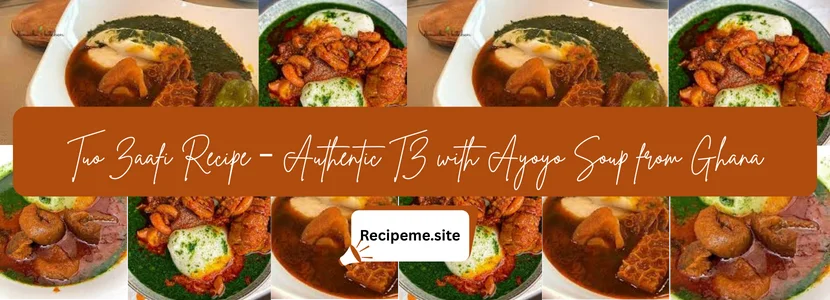
Introduction
Have you ever tasted a dish so unique in texture and flavor that it instantly transported you to a new culture? For many Ghanaians, that dish is Tuo Zaafi (TZ with Ayoyo Soup).
Soft, stretchy, and comforting, Tuo Zaafi is made from maize flour and often combined with cassava or millet flour. It is served with ayoyo (jute leaves) soup, a green, slightly slimy but highly nutritious delicacy. Together, they create one of Ghana’s most iconic meals—deeply nourishing and culturally significant.
I still remember my first encounter with Tuo Zaafi in Tamale, Northern Ghana. The communal spirit, the aroma of simmering soup, and the excitement as the smooth TZ was dished out made it more than just food—it was an experience.
Let’s take a journey into the world of Tuo Zaafi, exploring its history, preparation, and why it’s so special.
History of Tuo Zaafi
Tuo Zaafi originates from Northern Ghana, particularly among the Dagombas, and the name itself means “hot porridge” in the Hausa language. Over time, it has become a staple dish across Ghana, especially enjoyed on weekends or as a celebratory meal.
Historically, it was made with millet flour, since millet was widely grown in the North. As maize cultivation spread, maize flour became the dominant ingredient. The pairing with ayoyo soup—made from locally grown jute leaves—created a wholesome, balanced meal rich in carbohydrates, vitamins, and minerals.
Did you know? In some parts of Northern Ghana, Tuo Zaafi is so central to daily life that it is eaten more often than rice or yam!
Essential Ingredients
To prepare authentic Tuo Zaafi and Ayoyo Soup, you’ll need:
For Tuo Zaafi:
-
Maize flour (sometimes mixed with millet or cassava flour)
-
Water
-
Cassava flour (kokonte flour) for stretchiness
For Ayoyo Soup:
-
Jute leaves (ayoyo)
-
Dawadawa (locust bean seasoning) for depth
-
Meat (goat, beef, or chicken)
-
Fish (dried or smoked)
-
Onions, garlic, and ginger
-
Pepper (scotch bonnet or chili)
-
Tomatoes
-
Salt and seasoning cubes
-
Palm oil or vegetable oil
Optional: okra, ground melon seeds (agushie), or beans for thicker consistency.
Variations of Tuo Zaafi
Like most Ghanaian dishes, TZ has regional and household variations:
-
Millet TZ – the traditional version, still popular in rural areas.
-
Cassava mix TZ – more elastic and smooth.
-
Ayoyo with okra – for extra thickness and sliminess.
-
Vegetarian TZ – with beans or mushrooms instead of meat.
-
Luxury TZ – served with assorted meats, smoked fish, and boiled eggs.
Preparation (Step-by-Step Guide)
Step 1: Preparing Tuo Zaafi
-
Boil water in a deep pot.
-
Mix some maize flour with water to form a slurry (to prevent lumps).
-
Pour slurry into boiling water while stirring.
-
Gradually add dry maize flour while stirring with a wooden stick (banku ‘ta’ or wooden ladle).
-
Add a little cassava flour for elasticity.
-
Stir continuously until smooth and stretchy.
-
Mold into round balls for serving.
Step 2: Making Ayoyo Soup
-
Wash jute leaves thoroughly.
-
Blend onions, garlic, ginger, and pepper.
-
Boil meat and fish with seasoning cubes and salt.
-
Add blended spices, tomatoes, and dawadawa.
-
Stir in jute leaves (and optional okra) until slimy and well-cooked.
-
Add palm oil and simmer for richness.
Step 3: Serving
Serve the smooth Tuo Zaafi balls in a bowl and ladle the Ayoyo soup generously over them.
Cultural Significance
Tuo Zaafi is more than just food—it is culture, identity, and heritage. In Northern Ghana, it’s a symbol of hospitality. Families gather around large bowls, eating together with their hands.
It’s also a unifying meal: from the North to the South, rich to poor, young to old—TZ is enjoyed by all. It’s often prepared for special occasions like weddings, festivals, and funerals, representing abundance and community.
Serving Suggestions
-
Best enjoyed with Ayoyo soup for authenticity.
-
Can also be paired with groundnut soup, okra stew, or green leafy vegetable soups.
-
Often served with a side of fresh pepper sauce for spice lovers.
-
A chilled calabash of pito (local millet beer) or water completes the experience.
Types of Tuo Zaafi
-
Everyday TZ – simple, with one type of protein.
-
Celebration TZ – assorted meats, eggs, smoked fish.
-
Vegetarian TZ – made with beans or mushrooms.
-
Modern Restaurant TZ – served with creative twists like avocado salad.
Tips for Making Perfect TZ
-
Always stir continuously to avoid lumps.
-
Add cassava flour gradually—too much makes it gummy.
-
Use fresh ayoyo leaves for the best flavor.
-
Simmer the soup slowly to enhance its richness.
-
If ayoyo leaves aren’t available, substitute with spinach or kale (though the texture will differ).
Did you know? Dawadawa, a key seasoning in Ayoyo soup, is not only flavorful but also packed with protein and probiotics, making TZ a nutritious powerhouse!
Other Valuable Information
Tuo Zaafi is gluten-free (when prepared without wheat additives) and rich in fiber. Ayoyo leaves are high in vitamin A, vitamin C, calcium, and iron, making the dish both hearty and healthy.
It’s also eco-friendly—most ingredients are locally sourced, supporting rural farmers.
Personal Experience / Journey of Discovery
When I traveled to Bolgatanga, I was invited to a family lunch where Tuo Zaafi was served. Watching the women skillfully stir the TZ, I realized it’s more than cooking—it’s an art form requiring strength and precision.
Eating with my hands, sharing from one bowl, and laughing together made me appreciate not just the food, but the culture of unity it represents.
A Reflective Closing
Tuo Zaafi (TZ with Ayoyo Soup) is more than Ghana’s Northern delicacy—it’s a story of resilience, tradition, and community. Its unique texture and rich flavors tell the tale of a people who turn simple ingredients into an extraordinary meal.
If you’re seeking to experience Ghanaian culture in its most authentic form, Tuo Zaafi is the dish you must try. Once you taste it, you’ll understand why it holds a special place in the hearts of Ghanaians.
Frequently Asked Questions
1. What is Tuo Zaafi made of?
It’s made from maize flour (sometimes mixed with millet or cassava flour), stirred into a smooth, stretchy meal.
2. Why is Ayoyo soup slimy?
Ayoyo (jute leaves) naturally release mucilage when cooked, giving the soup its slimy texture—similar to okra.
3. Can I make Tuo Zaafi without ayoyo leaves?
Yes. You can substitute spinach or kale, though the taste and texture will differ.
4. Is Tuo Zaafi healthy?
Absolutely. It’s gluten-free, rich in fiber, and paired with nutrient-dense ayoyo leaves, making it a balanced meal.
5. How is Tuo Zaafi different from Banku?
While both are maize-based, Banku is fermented and slightly sour, while TZ is smooth, non-fermented, and more elastic.
6. Can Tuo Zaafi be made ahead of time?
Yes. The soup can be prepared in advance, but the TZ itself is best enjoyed fresh and hot.
